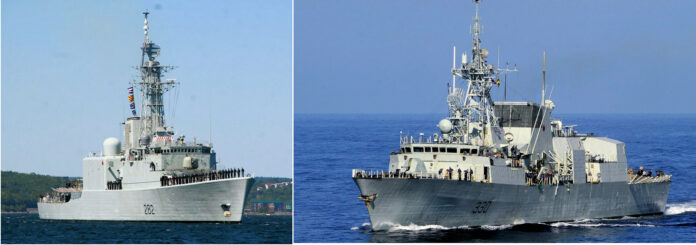
At a Caribbean Community summit on Feb. 16 in the Bahamas, Justin Trudeau announced that Canada would deploy two naval vessels to Haiti. Canada’s prime minister made the announcement to please Washington and prod the small, largely Black, Caribbean nations to dispatch their forces to a nation born in a revolt against racial slavery.
As an antidote to the inevitable mainstream media sugar-coated reports praising the mission to “help” Haiti, here’s a quick history of Canadian naval interventions in that neighborhood:
- “Since 1960, Canada has used its military forces at least 26 times in the Caribbean to support Canadian foreign policy,” wrote Sean Maloney in the 2000 book Canadian Gunboat Diplomacy. Canadian gunships have been sent to Haiti on multiple occasions.
- After a deadly earthquake rocked Haiti in 2010, the government deployed two vessels and 2,000 troops instead of Canada’s Heavy Urban Search and Rescue (HUSAR) Teams, which are trained to “locate trapped persons in collapsed structures.” According to internal documents the Canadian Press examined after the disaster, government officials feared that post-earthquake “political fragility has increased the risks of a popular uprising, and has fed the rumor that ex-president Jean-Bertrand Aristide, currently in exile in South Africa, wants to organize a return to power.” HMCS Athabascan and Halifax were part of Canada’s deployment to police Haiti’s traumatized and suffering population. Understanding the public wanted Canada to aid earthquake victims, Prime Minister Stephen Harper told the press, “ships of the Atlantic fleet were immediately ordered to Haiti from Halifax, loaded with relief supplies.” Not true. “A [Halifax] Chronicle Herald reporter and photographer embedded with the military for the mission observed that they didn’t have much food, water, medical equipment or tents to distribute, beyond what they needed for their own crews.” Nor did HMCS Athabaskan bring much food or water, according to a Canadian Press report.
- In the early 1990s Canadian warships enforcing a trade embargo on Haiti ignored internal legal advice by handing over Haitian “boat people” to U.S. vessels. According to a government opinion uncovered by the Canadian Council for Refugees, “there is some legal basis to an argument that, once on board a Canadian naval vessel, asylum seekers have access to the Canadian refugee-determination system.” Rather than bring a few hundred Haitians picked up at sea to Canada to determine their status, the Canadian vessels took them to the U.S. Navy base at Guantanamo Bay.
- After the 30-year father/son Duvalier dictatorship fell in February 1986, Ottawa backed efforts to maintain “Duvalierism without Duvalier.” In response to upheaval in the years after Jean Claude “Baby Doc” Duvalier fled Haiti, warships were deployed in 1987 and 1988.
- In 1974, a Canadian warship was deployed as well. According to Maloney, “Canadian naval vessels carried out humanitarian aid operations to generate goodwill with the Haitian government so that Haiti would support Canadian initiatives in la Francophonie designed to limit French interference in Canadian affairs.”
- As François “Papa Doc” Duvalier’s first mandate neared its end in May 1963, the country was plunged into upheaval. Former head of the Tonton Macoutes, Clément Barbot, launched a bid to topple Duvalier and recently elected leftist Dominican President Juan Bosch supported opponents of Papa Doc. Bosch threatened to invade after two police entered and many Macoutes surrounded the Dominican Embassy in Port-au-Prince to chase down Haitian military officers accused of plotting against Duvalier. The CIA worried that forces sympathetic to Cuba might take advantage of the instability to grab power. Amidst the political turbulence, Canada’s HMCS Saskatchewan, a British vessel, and seven S. warships approached Haiti to guard against a Cuban-inspired guerilla movement.
- When Papa Doc declared himself “President-for-Life” the next year, the HMCS Saskatchewan was once again deployed. The objective appears to have been to ensure Duvalier did not move towards Cuba. Prime Minister Lester Pearson justified sending the vessel by noting that “if Canadian nuns or priests should be wounded or killed, it would be difficult to explain why the Canadian government had not … taken some form of action.”
- From the mid-1850s to 1915 French, German, British, and S. naval ships were dispatched dozens of times to intimidate Haitian leaders to press them to pay their banks or other capitalist interests. In November 1865, the British frigate HMS Galatea bombed Cap-Haïtien in support of a Haitian political leader who was battling an opponent. Based in Halifax and Bermuda, the Galatea was part of the British Empire’s North America and West Indies Station. Two decades later HMS Canada, which was stationed in Halifax, was dispatched to Haiti on two occasions over six-months. In one instance marines from the ship landed.
- Even before Haiti became independent, “Canadian” gunboats were dispatched to fight the revolutionaries’ struggle to end slavery. In a bid to crush the ex-slaves before their example spread to the English colonies, British forces invaded Haiti in 1793. Home to Britain’s primary naval base in North America, Halifax played a part in London’s efforts to capture the incredibly lucrative colony of Saint-Domingue. Much of the Halifax-based squadron was sent there in 1793.
Canada should not send warships to prop up the unelected, unconstitutional, and unpopular Ariel Henry, who was appointed prime minister by the Core Group, led by the U.S. and Canada. It should not deploy naval vessels to Haiti to assist Washington and encourage Caribbean nations to send their forces.
Haiti has already faced far too much Canadian gunboat diplomacy.










